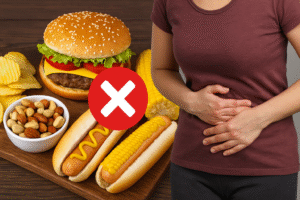Potassium is a vital mineral that aids the heart, nerves, and muscles in functioning properly. Though good for people in most cases, too much potassium can be dangerous — particularly for people with kidney problems, heart disease, or those taking potassium-sparing drugs. It’s important to know what high potassium foods to avoid to keep blood potassium levels safe.
So here are 9 high potassium foods to avoid or limit if you’re not comfortably managing your potassium intake.
1. Bananas

One of the most widely known high potassium foods to avoid is bananas. There is roughly 422 mg of potassium in a medium banana, and you could have a problem with this if you are trying to follow a low potassium diet.
“As convenient and nutritious as bananas are, they have too much potassium to be a frequent choice for people who need to limit potassium,” Spritz says.
Alternatives: Choose fruits such as apples, grapes or berries, which are lower in potassium.
2. Avocados

Whilst avocados comprise of healthy fats and fiber, they are also one of the foods high in potassium to stay away from. A medium avocado gives you 690 mg of potassium, and guacamole typically includes more than one serving.
As a result of this, avocados are really a food to pass on when you are attempting to reduce your intake of potassium.
Variation: Instead of avocado, use hummus or mashed green peas to get a creamy consistency.
3. Potatoes

White and sweet potatoes are considered to be high potassium foods to stay away from. about 900 mg of potassium in a medium baked potato (with the skin).
But in potatoes, potassium can be decreased by a double boiling process. Hops off the potatoes, boil peel them, cut them make them very small, boil them, pour off the water, put in more water, and boil again.
Or: Cauliflower, rice or low-potassium vegetables like zucchini also work.
4. Spinach (Cooked)

Cooked spinach is a healthy food but also one of such high potassium foods to avoid. A 1-cup serving of cooked spinach delivers more than 800 milligrams of potassium and is a better source of potassium than raw spinach because the boiling process reduces the leaves’ volume.
Substitute: Limit raw spinach if you have it or eat lettuce or cabbage instead, which are lower in potassium.
5. Oranges and Orange Juice

They may appear healthy, but oranges are considered high potassium foods to avoid when they are eating potassium-restricted diet. One medium orange has approximately 240 mg of potassium, and 8 oz. of orange juice supplies up to 470 mg.
Alternative: Opt for fruits such as apples or cranberries and drink apple or grape juice instead.
6. Tomatoes and Tomato Products

Raw tomatoes are moderate potassium foods but with the concentrated forms such as tomato sauce, paste and juice they are definitely weighted as one of the high potassium foods to avoid. All that in just 1/4 cup of tomato paste, which contains over 660 mg of potassium.
Tomato based sauces and soups- sauces and soups that use tomato base can easily access more potassium.
Alternative: Try the roasted red pepper with sauce, or a splash of fresh tomato, instead of paste.
7. Dried Fruits

Apricots, raisins, prunes, and dates are dehydrated fruits that contain concentrated potassium levels and are considered a high potassium food to stay away from. And 1/2 cup dried apricots for can have more than 1100 mg potassium.
Dried fruits take out the water, but leave all the minerals so they become risky choices for those on a low-potassium diet.
Option: Eat fresh fruit, such as watermelon, blueberries or pears that are much lower in potassium.
8. Beans and Lentils

Beans are some of the best sources of plant protein and fiber, but also high-potassium food to avoid when trying to control your potassium intake. Cooked lentils have around 730 mg of potassium per cup, while black beans tally around 600 mg.
These other foods may be healthy in general but are not appropriate for those on a potassium restricted diet.
Substitute: Instead of mashed potatoes, you could opt for white rice, pasta or green beans if the cook wants to go the low-potassium route.
9. Milk and Yogurt

Dairy gets left off the list of high potassium foods to avoid, but it’ll stack up on you in no time. A cup of milk contains approximately 350–400 mg of potassium and yogurt can range from 300–500 mg per serving.
The fact is, these numbers can add up quickly when you eat dairy every day in some form—milk, cheese, yogurt or cream.
Substitute: You can also use almond milk, rice milk, or even coconut milk (plain) instead.
Why it’s Important for You to Learn About High Potassium Foods to Avoid
It is important to monitor your potassium intake if you have kidney disease, or heart issues, and are taking certain medications. Normally, your body regulates the amount of potassium in your blood by flushing out any excess potassium through the kidneys. But when the kidneys malfunction, potassium can accumulate in the blood, causing hyperkalemia, a potentially fatal condition that affects the heart.
The first step is getting to know which foods are high in potassium. Many people end up consuming a lot of potentially high potassium foods to avoid all in 1 meal without even being aware of it— such as potatoes (tubers) with tomato sauce, sprinkled with cheese and a banana on the side.
How to Control Potassium Intake
A list of recommendations for managing high-potassium foods includes the following general tips:
- Boil your veggies: Boiling can effectively reduce potassium levels to about half of the original amount.
- Mind portion sizes: Even nutritious foods can be problematic in large amounts.
- Read labels: Check for a “low potassium” or a “renal friendly” label.
- Visit a dietitian: A dietitian can aid you in coming up with a meal plan that’s suitable for your situation.
- Don’t eat multiple high-potassium foods at the same time. Space them out.
Final Thoughts
Avoiding high potassium foods makes a huge difference! Most of these foods are considered healthy for those who don’t have to limit potassium. Thankfully, there are lots of yummy, low-potassium substitutes out there.
If you’re not sure how much potassium is right for you, check with your doctor or a registered dietitian. They can offer you personalized advice in line with your health profile.
You can preserve good-for-you potassium levels without sacrificing flavor or nutrients – simply make smart swaps and check in on your intake from time to time.








